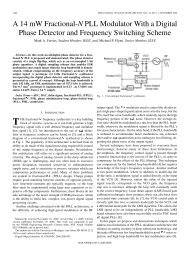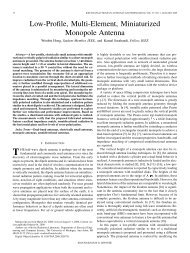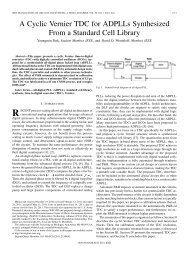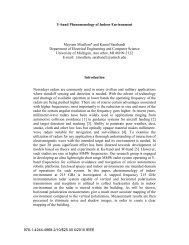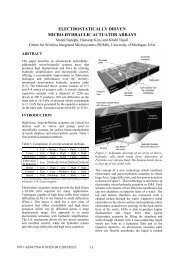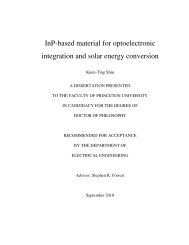Subwavelength Radio Repeater System Utilizing ... - IEEE Xplore
Subwavelength Radio Repeater System Utilizing ... - IEEE Xplore
Subwavelength Radio Repeater System Utilizing ... - IEEE Xplore
- No tags were found...
Create successful ePaper yourself
Turn your PDF publications into a flip-book with our unique Google optimized e-Paper software.
<strong>IEEE</strong> TRANSACTIONS ON ANTENNAS AND PROPAGATION, VOL. 59, NO. 7, JULY 2011 2683<strong>Subwavelength</strong> <strong>Radio</strong> <strong>Repeater</strong> <strong>System</strong><strong>Utilizing</strong> Miniaturized Antennas andMetamaterial Channel IsolatorKamal Sarabandi, Fellow, <strong>IEEE</strong>, and Young Jun Song, Student Member, <strong>IEEE</strong>Abstract—Implementation of a novel high gain miniaturizedradio repeater for improving wireless network connectivity incomplex environment is presented in this paper. Unlike existingrepeater systems, this system utilizes two closely spaced lowprofile miniaturized planar antennas capable of producing omnidirectionaland vertical radiation pattern as well as a channelisolator layer that serves to decouple the adjacent antennas. Themetamaterial based channel isolator serves as an electromagneticshield, thus enabling it to be built in a sub-wavelength size of0 07 2 0 0 014 0 , the smallest repeater ever built. A prototypeof the small radio repeater is fabricated to verify the design performancethrough a standard free-space measurement setup. Thefeasibility of amplifying and re-transmitting the received signal isdemonstrated through measurement which compares well withthe numerical simulation results.Index Terms—Antenna array mutual coupling, electromagneticshielding, indoor radio communication, multiaccesscommunication.I. INTRODUCTIONA. Background of This StudyFOR wireless network systems, the path-loss between thetransmitter and receiver is a critical factor that determinesthe possible range of communication between two nodes.Complex environments such as urban canyons and buildinginteriors often contain numerous obstacles that impede theline-of-sight (LOS) communication and increase the path-loss.The existing long range ad-hoc communication network relieson multipath (multiple reflection, diffraction, and penetrationthrough obstacles). In these environments especially at highfrequencies the path-loss dramatically increases, which oftenrequires higher transmitter power and closely spaced communicationnodes. Furthermore, as transmitter power increases oras transmitting nodes become closer, the potential for mutualinterference between communication cells increases which,Manuscript received January 13, 2010; revised November 04, 2010; acceptedDecember 10, 2010. Date of publication May 10, 2011; date of current versionJuly 07, 2011. This research was supported by the U.S. Army Research Laboratoryunder contract W911NF and prepared through collaborative participationin the Microelectronics Center of Micro Autonomous <strong>System</strong>s and Technology(MAST) Collaborative Technology Alliance (CTA).The authors are with the Radiation Laboratory, Department of ElectricalEngineering and Computer Science, The University of Michigan at AnnArbor, Ann Arbor, MI 48109-2122 USA (e-mail: saraband@eecs.umich.edu;yjsong@umich.edu).Color versions of one or more of the figures in this paper are available onlineat http://ieeexplore.ieee.org.Digital Object Identifier 10.1109/TAP.2011.2152320if present, can cause degradation in coverage capacity. Additionally,a topology that uses closely spaced nodes will bemore expensive than a similar topology sparsely populatedwith nodes. To overcome these situations and to help improvethe ground area coverage of communication signals withoutincreasing the transmitter power, radio repeaters have beenextensively used in various application scenarios. Numerousstudies regarding feasibility and operation of the radio repeaterhave been presented in [1]–[4].Additionally, numerous commercial products utilizing theconcept of the radio repeater have been introduced and fabricatedsuch as in [5] and [6]. The main objective of the radiorepeater in these scenarios is to achieve enhanced connectivityby amplifying a radio signal through an active device as shownin Fig. 1. For the downlink communication, from a base stationto an end-node/unit, the signal originating at the base station islinked through the Receive antenna (RX) of repeater, amplified,and retransmitted through the Transmit antenna (TX), and viceversa for the uplink direction. However, the mutual couplingbetween a repeater’s RX and TX antennas generates a positivefeedback loop as shown in Fig. 1. When the gain of the RFamplifier is greater than the isolation level of the RX and TXantennas, the overall system will start to oscillate, and the communicationcoverage of that micro cell cannot be established.Thus, the level of mutual coupling limits the performance of aradio repeater as well as the dimension and cost of the overallsystem. To circumvent this intrinsic problem, generally two approacheshave been proposed. The first method is to divide thefrequencies of the uplink and downlink signals. This methodologyutilizes a frequency division duplex (FDD) to reduce themutual coupling by separating signal frequencies. However, itrequires complex circuitry, larger size, and a common protocolto manage frequency allocation, which all imply higher costand much more power consumption. The second method is toadapt a time division duplex (TDD) in time domain. This alsointroduces additional logic circuitry, latency, and knowledge ofthe repeater, transmitter and receiver locations, as presented in[7] and [8].In this paper, a new device is proposed to overcome theadverse effect of various complex environments by reducingthe path-loss. To enhance radio connectivity and maintainlow-power communication, a very small radio repeater witha large radar cross section (RCS) and an omnidirectionalradiation pattern is proposed. The proposed radio repeaterreceives the LOS signal from the transmitter, amplifies it, andthen retransmits the amplified signal omnidirectionally, whichestablishes a secondary LOS to arbitrary receivers. Thus, a0018-926X/$26.00 © 2011 <strong>IEEE</strong>
2684 <strong>IEEE</strong> TRANSACTIONS ON ANTENNAS AND PROPAGATION, VOL. 59, NO. 7, JULY 2011Fig. 1. Schematic of radio link using radio repeater.Fig. 3. Modified MMA: (a) topology of modified MMA for small radio repeater;(b) design parameters.TABLE IDESIGNED PARAMETERS OF MODIFIED MMAFig. 2. Schematic of proposed small radio repeater.series of small radio repeaters can enhance radio connectivityby establishing a LOS with the repeater nodes.B. Benefits of the Proposed Small <strong>Radio</strong> <strong>Repeater</strong>Fig. 2 shows the proposed Small <strong>Radio</strong> <strong>Repeater</strong>. It consistsof two miniaturized planar antennas capable of supporting anomnidirectional pattern and vertical polarization. Additionally,a metamaterial based isolator structure is used, and active RFamplification circuitry as well as a battery is integrated intothe radio repeater platform. Since RX/TX of the proposed repeatershows omnidirectionality over the H plane, the uplink anddownlink signal paths can be established through a single circuitpath. This can reduce complexity and power consumption ofRF circuitry. In addition, pure vertical polarization allows for asimple antenna structure for the base station and end-node/unitsas well as a decreased path-loss along the channel. It is wellunderstood that for near-earth wave propagation scenarios verticallypolarized waves experience much less path-loss comparedto horizontally polarized waves as presented in [9]. Toachieve the compact dimension of the radio repeater, a metamaterialbased channel isolator is utilized. By generating thenormal magnetic field along the signal path between RX andTX, artificial magnetic walls are generated that serve to suppressthe electromagnetic wave propagation from RX to TX antennas.The proposed radio repeater occupies a very small areawith a very short height without its activecircuitry. The passive components such as two miniaturizedantennas and metamaterial based isolator are presented andverified in this paper. The prototype is fabricated using acommercially available dielectric substrate. In addition, acommercially available RF amplifier and battery are used toverify the operational feasibility of the proposed repeater. Thisconfiguration is shown to boost the power level of the receivedsignal by 32 dB.II. DESIGN SPECIFICATIONSA. Miniaturized <strong>Repeater</strong> AntennaAccording to antenna theory, the intensity and polarization ofthe radiated field are proportional to the level and direction of thecurrent distribution over the antenna. In many practical miniaturizedantennas, the level of the excited current is limited bythe impedance mismatch between the feeding network and theantenna itself. To achieve a low-profile miniaturized antenna,a quarter-wave microstrip resonator fed near the short-circuitedend is used. To achieve miniaturization and impedance matchinga four-arm spiral shape quarter-wave resonator structure wasutilized and presented in [10]. Although a good input reflectioncoefficient at the frequency of operation can be obtained,this antenna requires two layers; an upper layer consisting ofthe open-ended spiral shape line and a lower layer consisting ofthe short-circuited transmission line for the matching network toradiate the power effectively. This physical structure increasescomplexity and cost for fabrication. And any misalignment betweenthe two layers can shift the operation frequency.The proposed new approach is to place the matching networkat the same layer of the miniaturized antenna as shownin Fig. 3. Although the main radiation is from the shorted pins,some radiation is emanated from the spiral arms. The polarizationof the radiated field from the spiral arms is horizontal.Therefore, each of the spiral arms should be placed in a symmetricalmanner in order to minimize horizontally polarized radiatedfield. Symmetry of these arms is essential to cancel suchradiated fields and eventually achieve an omnidirectional verticallypolarized radiation pattern. In addition, symmetry andclose spacingof the shorting pins enablethe excited currents through these pins to be in-phase. The shortcircuited currents that pass through the four vertical pins are thedominant radiating elements and responsible for the verticallypolarized radiated field. The optimized miniaturized multi-elementsmonopole antenna (MMA) is designed using a commercialfinite element method solver (Ansoft’s HFSS ver. 11.1).To be incorporated into the small radio repeater, the optimizedMMA must be further modified to achieve smaller dimensions.Because of the sub-wavelength dimension of the proposed radio
SARABANDI AND SONG: SUBWAVELENGTH RADIO REPEATER SYSTEM UTILIZING MINIATURIZED ANTENNAS 2685Fig. 4. Simulated responses of modified MMA: (a) S response; (b) radiation pattern in E(zx) plane; (c) radiation pattern in E(yz) plane; (d) radiation pattern inH(xy) plane.repeater, a pair of the optimized MMA with four arms can producea high level of mutual coupling within the small groundplane. Thus, the objective is to modify the MMA geometry sothat mutual coupling can be reduced while maintaining the polarizationpurity and the desired radiation pattern. By utilizingonly two arms of the MMA with a symmetric topology as shownin Fig. 3, the horizontal current cancellation and reduction ofmutual coupling can be achieved at the expense of an asymmetricradiation pattern in the E plane. The modified MMAis designed and verified using Ansoft’s HFSS. The designedtopology and parameters are shown in Fig. 3. The physical dimensionsare optimized for operation around 2.5 GHz and summarizedin Table I. And all line length and spacing (betweentraces) values are set to 0.4 mm, except for , and whichare set to 0.6 mm. Fig. 4(a) presents the simulated input reflectioncoefficient of the modified MMA. As can be seen, the modifiedMMA shows a 18.5 dB of input reflection coefficientat the design frequency. The radiation pattern of the modifiedMMA is shown in Fig. 4(b), (c), and (d). The vertical polarizationin the H-plane shows an omnidirectional pattern, similarto that of a monopole. In addition, the level of the horizontalpolarization in the H-plane is negligible compared to the verticalpolarization, which implies that the cancellation betweenhorizontal electric current is achieved effectively. Furthermore,the transmission line based antenna can be fabricated using thestandard printed circuit technology. This serves to reduce thealignment error observed in the multi-layer design, and hencethe fabrication process and the discrepancy between the simulationand measurement are reduced significantly.B. Metamaterial Based Channel IsolatorIn practical antenna systems, the mutual coupling betweenadjacent antennas restricts compact integration of multiple antennasin a small area for applications such as multiple inputand multiple output (MIMO) communication systems. To suppressthe mutual coupling, various approaches have been studiedand presented in [11]–[13]. In general, these studies can be categorizedinto two approaches. The first method is to engineerthe electric and magnetic properties of the material, such as thepermittivity and permeability, by introducing an artificial structure.For example, a mushroom-like structure can suppress themutual coupling by introducing a negative refractive index, asshown in [11] and [12]. Another method utilizes metamaterialinsulators to block the EM energy from being transmitted acrossthe insulation boundary, as shown in [13]. This metamaterial insulatorconsists of magneto-dielectric embedded circuits, whichcan be modeled as parallel LC resonant circuits. However, bothapproaches have intrinsic limitations when attempting to suppressthe mutual coupling of antennas at the commercial ISM
2686 <strong>IEEE</strong> TRANSACTIONS ON ANTENNAS AND PROPAGATION, VOL. 59, NO. 7, JULY 2011TABLE IIDESIGNED PARAMETERS OF CHANNEL ISOLATORFig. 5. Unit cell of channel isolator: (a) topology of unit cell; (b) square loopby image theory.frequency band (around 2.5 GHz). The artificial structure requireslarge physical dimensions, and the metamaterial insulatorcauses fabrication complexity and cost.To address these limitations, a metamaterial based channelisolator is proposed and designed as shown in Fig. 5(a). The proposedisolator is designed to resonate at the desired channel frequencyand decrease the mutual coupling by suppression of thesurface waves in the substrate generated by the vertical pins ofthe MMA. The vertical pins create a transverse magnetic (TM)wave in the substrate with zero cutoff frequency. The magneticfield is parallel to the ground plane and perpendicular to the pins.To inhibit propagation of the TM surface wave, an electromagneticband-gap (EBG) metamaterial layer can be utilized. Theadvantage of the band-gap material is that it creates an equivalentopen circuit to the surface wave as opposed to a short-circuitthat a metallic wall can produce.The band-gap metamaterial consists of an array of the parallelLC resonant circuits that are magnetically coupled with the substratemode. This is realized using unit cells that consist of verticalwires and horizontal conducting strips, which behave likea distributed inductor and a distributed capacitor, respectively.Using image theory, when each loop is imaged a larger loophaving a larger inductance and a smaller capacitance is formedas shown in Fig. 5(b). Assuming the fundamental mode propagatesfrom the TX to the RX through the substrate, the horizontallypolarized magnetic field linked by the square loop inducesan electric current on the vertical wires. In addition, this inducedcurrent generates a magnetic field which is perpendicular to theloop. When the unit cells are closely spaced to each other, theinductance of the loops is increased and the periodic array actslike a solenoid. At resonance the periodic layer acts as a perfectmagnetic conductor (PMC) plane. Due to the mutual couplingof the adjacent loops, the self inductance of the square loop asshown in Fig. 5(b) can be obtained from [14]where is the internal area of the loop and isthe periodicity of unit cells.The quality factor (Q) of the equivalent single pole isolatoraffects the performance and isolation bandwidth. Thus, commerciallumped capacitors with finite deviation of capacitance(1)values and low Q factor will cause the suppression of the mutualcoupling to deteriorate. To simultaneously reduce the deviationof these values, improve the Q factor, and lower the cost offabrication, printed circuit technology can be utilized to implementthe capacitors. As mentioned, the magnetic field inducesthe electric current on the vertical wires, and this current transformsto a displacement current (electric field) as it gets throughthe gaps between the fingers of the series interdigital capacitor.As most of the electric field between the metallic strips of thiscapacitor is in the gap and perpendicular to the metallic edges,its capacitance can be computed from the capacitance per unitlength of two thin co-planar strips given by [15]where is the metallization ratio and isthe complete elliptic integral of first kind defined bySince the individual capacitors between fingers are connectedin parallel, the total capacitance per unit length of interdigitalcapacitor is equal towhere is the capacitance between inner strips, is betweenouter and inner strips, and is the number of fingers. Hence,the total capacitance of the proposed isolator can be calculatedeasily from , where is the length of the fingers.The interdigital capacitor is centered between two verticalwires. The designed parameters are summarized in Table II. Thelength and height of the unit cell are chosen to be 6.25 mm1.57 mm. The corresponding inductance and capacitance of theunit cell are thus found to be 15.2132 nH and 0.1869 pF, respectively.Based on this calculation, the self resonant frequency iscalculated to be 2.98 GHz.III. PARAMETRIC STUDIES AND OPTIMIZATIONA. Optimal Configuration Without the IsolatorIn Section II, the principle of operation of the MMA was established.The modified MMA with two symmetric arms andvertical pins was designed on a small ground plane and was(2)(3)(4)(5)
SARABANDI AND SONG: SUBWAVELENGTH RADIO REPEATER SYSTEM UTILIZING MINIATURIZED ANTENNAS 2687Fig. 6. <strong>Repeater</strong> platform without channel isolator.shown to produce a very good impedance match and verticalpolarization. This design is further optimized to be integratedinto the channel isolator as shown in Fig. 6. As mentioned before,two arms of the original MMAs that would come close tothe metamaterial isolator are removed. The magnetic field fromthese arms could have coupled to the isolator loops and establisheda link between the two antennas instead of isolating them.In a miniaturized antenna, the size of the ground plane can alsoaffect the performance of the antenna. The edge currents on theground plane affect the radiation pattern, directivity, and polarization.To maintain small physical dimensions, the design parametersfor the optimized configuration include the position ofthe TX and RX antennas as well as the dimensions of the groundplane. The optimization is performed using HFSS to achieveimpedance matching at the desired frequency, maintaining anisolation level smaller than 20 dB, and minimizing the size ofthe ground plane.Fig. 7(a) represents a parametric study where the simulationresponses of (coupling) between RX and TX antennas aredisplayed. In this simulation the spacing between the antennaand edges of the ground plane are fixed and the distance betweenthe two antennas, is varied. As can be seen, the distancebetween the two antennas does not play a major role in the mutualcoupling between the two antennas. This implies that theamount of coupling from surface wave propagation is not affectedby the separation distance within the specified range ofdistances shown in Fig. 7(a). However, in choosing the groundplane size the overall dimension of the small radio repeater platformand the space for the channel isolator should be taken intoaccount to avoid any interaction between the two antennas andthe channel isolator. The optimized distance between the twoantennas is found to be 25 mm. In addition, the width of theground plane affects the level of mutual coupling due to excitationof edge currents. This effect is shown in Fig. 7(b) whereall other dimensions are fixed ( , )and is changed. To account for the integration of an RF amplifieron the backside, the dimensions of the platform are finallychosen to be 40.01 mm 20.68 mm, which correspondsto .B. Isolator and Antenna IntegrationThe geometry of the proposed miniaturized radio repeater iscomposed of two miniaturized low-profile antennas capable ofradiating vertical polarization and a metamaterial isolator layeras shown in Fig. 8. As mentioned before, close spacing betweenthe antennas and the isolator causes the mutual coupling, andFig. 7. Simulated coupling between antennas shown in Fig. 6: (a) varying thedistance between RX and TX; (b) varying ground plane width.Fig. 8. <strong>Repeater</strong> platform with channel isolator.therefore it affects the performance of the repeater. Specifically,the antennas input impedances and the resonant frequency of theisolator both change as a result of the placement of the antennasand the isolator. The current distribution on the ground plane isused to evaluate the optimal placement of the isolator. As all ofthe physical parameters are related to each other through variouselectromagnetic interactions, optimization is achieved throughadjusting the length of the isolator loop and the strip iterativelyusing HFSS.As an initial step in the design, the RX and TX antennas aswell as the isolator are designed separately. For integration,since multiple resonant structures within sub-wavelength dimensionsare used, the use of manual mesh modifications inHFSS is required to capture the details of the fields around theisolator. The designed topology is in Fig. 8. Physical parameters
2688 <strong>IEEE</strong> TRANSACTIONS ON ANTENNAS AND PROPAGATION, VOL. 59, NO. 7, JULY 2011TABLE IIIDESIGNED PARAMETERS OF THE SMALL RADIO REPEATERFig. 10. Simulated radiation pattern: (a) single ground plane without isolator;(b) separated ground planes without isolator; (c) single ground plane withchannel isolator.Fig. 9. Simulated S-parameters of the small radio repeater with and withoutthe metamaterial isolator.are optimized for the repeater to operate around 2.72 GHz andare reported in Table III. The optimized simulation responseand measured data are discussed in Sections IV and V.IV. REPEATER SIMULATION RESULTSIn this section full-wave analysis is carried out to examinethe performance of the proposed repeater. Fig. 9 shows the simulatedS-parameters of the optimized small radio repeater platform.As shown, a 20 dB of transmission coefficient can beachieved between the TX and RX antennas without the channelisolator with designed dimensions (assuming the two antennasare well matched.) Incorporating the channel isolator, the transmissioncoefficient drops to 30 dB. Also shown is that the antennaresponse is affected due to the interaction between the antennasand the isolator. In fact, per our design the antennas arewell matched (over 15 dB of input reflection coefficient), andthe center frequency is at the desired value in the presence ofthe isolator. The presence of the antenna also affects the isolatorfrequency response. As shown before, the resonant frequency ofan isolated unit cell of the metamaterial isolator is at 2.98 GHz.With some small adjustments, in the presence of the antenna,this resonance occurs at 2.72 GHz as shown in Fig. 9.It should be noted here that if the ground planes of transmitand receive antennas are disconnected improved isolation canbe achieved. However, this way no amplifier can be insertedbetween the transmit and receive antennas.The simulated radiation patterns in H plane are representedin Fig. 10. In order to provide enough area for two modifiedantennas and a channel isolator, the ground plane should be extendedalong the longitudinal direction, which breaks the symmetryof the ground plane. Although the modified MMA withsquare ground plane shows pure vertical polarization in H plane(see Fig. 4(d)), the horizontal induced current on the rectangularground plane generates horizontal polarization in H plane asshown in Fig. 10(a). In all cases, however, the antenna showsaround 9 dBi of gain in vertical polarization. The gain ofthe antenna is limited due to dielectric and metallic losses. Increasingthe dielectric thickness and increasing antenna dimensionsincrease the gain. Also it should be noted that the distancebetween two antennas is about 25 mm. For such small separations,the coupling mainly comes from the antennas’ near field.Fig. 11 shows the magnetic field distribution over the groundplane for the repeater with and without the isolator. As expected,the horizontal magnetic field generated from the lower antennain Fig. 11(a) propagates through the substrate and produces themutual coupling to the top antenna. When incorporating thechannel isolator, Fig. 11(b) indicates that the horizontal magneticfield is maximized within the channel isolator. This impliesthat the surface currents (perpendicular to the direction ofmagnetic field in the channel isolator) are interrupted by the isolator,as shown in Fig. 12.V. EXPERIMENTAL RESULTSThe prototype of the proposed small radio repeater systemis fabricated using a 1.57 mm-thick Rogers RO-5880 substrate, as shown in Fig. 13. Fig. 14 shows the measuredS-parameters of the small radio repeater and indicates that theresonant frequency is located at 2.72 GHz. Since the fabricationprocess includes physical limitations such as under cutting
SARABANDI AND SONG: SUBWAVELENGTH RADIO REPEATER SYSTEM UTILIZING MINIATURIZED ANTENNAS 2689Fig. 13.Fabricated small radio repeater w/wo channel isolator.Fig. 11. Simulated H field distribution: (a) small radio repeater without channelisolator; (b) small radio repeater with channel isolator.Fig. 14. Measured S-parameters of proposed small radio repeater with andwithout channel isolator.Fig. 15. Verification for operation of small radio repeater.Fig. 12. Simulated current distribution: (a) small radio repeater withoutchannel isolator; (b) small radio repeater with channel isolator.of the copper in the etching process and errors in alignment,the frequency shift between the computer based design and actualfabrication is unavoidable. However, this discrepancy canbe corrected after a few trials. In addition, post tuning and optimizationcan be used to obtain the designed performance.Fig. 15 shows the system setup for the measuring of S-parameters.To feed each of antennas, two microstrip transmissionlines are used where one is connected to an amplifier withvariable gain and its output is connected to the other antennathrough a directional coupler. The directional coupler is insertedbetween RF amplifier and transmit antenna to monitor the occurrenceof oscillation when it happens as the gain is increased. Ascan be seen in Fig. 14, the repeater without the channel isolatorshows a 18 dB of transmission coefficient, and the proposedrepeater shows a 42 dB of transmission coefficient, which indicates24 dB of suppression improvement. With the channelisolator, 28 dB of peak level of is observed, however, inspite of 1 dB of insertion loss from the directional coupler, amaximum gain of 32 dB for a wideband RF amplifier can beutilized with this repeater. Since the antennas are slightly mismatchednear to the desired frequency (2.72 GHz), the maximumgain can be higher than the peak level of . Therefore, itis verified that a commercial wideband RF amplifier with a gainof 32 dB can be integrated into the proposed repeater withoutoscillation.VI. CONCLUSIONSIn this paper, a new concept for implementation of miniaturizedradio repeater is presented. To construct the radiorepeater, two miniaturized low-profile antennas radiatingvertical polarization and a very thin metamaterialisolator layer are integrated into a compact configuration.The antennas are designed to have an omnidirectional radiationpattern to make the repeater insensitive to the positionsof the transmitter and receiver. In addition, the proposed
2690 <strong>IEEE</strong> TRANSACTIONS ON ANTENNAS AND PROPAGATION, VOL. 59, NO. 7, JULY 2011isolator is shown to suppress the mutual coupling, improvingthe transmission coefficient from 18 dB to 42dB. The dimensions of the TX/RX antennas and a unitcell of the isolator areand, respectively. Theoverall dimensions of the proposed radio repeater are, which correspondsto. The proposed radio repeatersystem has been simulated and verified experimentally. Theprototype of the design has been fabricated using printed circuittechnology, which serves to reduce fabrication complexity andallows for easy commercial production at a large scale.Such a radio repeater system can mitigate the adverse effectsof obstacles in radio connectivity for ad-hoc networks in complexenvironments.REFERENCES[1] S. K. Park, P.-J. Song, and G. S. Bae, “Joint optimization of radio repeaterlocation and linking in WLL systems with 2.3 GHz frequencyband,” in Proc. <strong>IEEE</strong> Int. Conf. on Communications, 1999, vol. 3, pp.1617–1621.[2] P. Slobodzian, “Estimation of the repeater gain required for a wirelesslink,” in Proc. 15th Int. Conf. on Microwaves, Radar and WirelessCommunications, May 2004, vol. 2, pp. 656–659.[3] J. Borkowski, J. Niemela, T. Isotalo, P. Lahdekorpi, and J. Lempiainen,“Utilization of an indoor DAS for repeater deployment in WCDMA,”in Proc. <strong>IEEE</strong> 63rd Vehicular Technology Conf., May 2006, vol. 3, pp.1112–1116.[4] A. H. Naemat, A. Tee, A. S. M. Marzuki, B. Mohmd, K. Khalil, and A.R. A. Rahim, “Achieving optimum in-building coverage of 3 G networkin Malaysia,” in Proc. <strong>IEEE</strong> Int. RF and Microwave Conf., Sep. 2006,pp. 343–346.[5] B. W. Lovinggood, M. D. Judd, and W. P. Kuiper, “Integrated <strong>Repeater</strong>,”U.S. Patent 6,934,511 B1, 2005.[6] D. L. Runyon, S. B. Thompson, J. W. Maxwell, and D. L. M. SR.,“Wireless <strong>Repeater</strong> With Feedback Suppression Features,” U.S. Patent2006/0 205 343 A1, 2006.[7] T. W. Ban, B. Y. Cho, W. Choi, and H.-S. Cho, “On the capacity of aDS/CDMA system with automatic on-off switching repeaters,” in Proc.<strong>IEEE</strong> Int. Conf. on Communications, 2001, vol. 3, pp. 780–784.[8] M. Lee, B. Keum, Y. Son, J.-W. Kim, and H. S. Lee, “A new low-complexinterference cancellation scheme for WCDMA indoor repeaters,”in Proc. <strong>IEEE</strong> Region 8 Int. Conf. on Computational Technologies inElectrical and Electronics Engineering, Jul. 2008, pp. 457–462.[9] D. Liao and K. Sarabandi, “Terminal-to-terminal hybrid full-wave simulationof low-profile, electrically-small, near-ground antennas,” <strong>IEEE</strong>Trans. Antennas Propag., vol. 56, no. 3, pp. 806–814, Mar. 2008.[10] W. Hong and K. Sarabandi, “Low-profile, multi-element, miniaturizedmonopole antenna,” <strong>IEEE</strong> Trans. Antennas Propag., vol. 57, no. 1, pp.72–80, Jan. 2009.[11] D. Sievenpiper, L. Zhang, R. Broas, N. Alexopolous, and E.Yablonovitch, “High-impedance electromagnetic surfaces with aforbidden frequency band,” <strong>IEEE</strong> Microw. Theory Tech., vol. 47, no.11, pp. 2059–2074, Nov. 1999.[12] F. Yang and Y. Rahmat-Samii, “Microstrip antennas integrated withelectromagnetic band-gap (EBG) structures: A low mutual couplingdesign for array applications,” <strong>IEEE</strong> Trans. Antennas Propag., vol. 51,no. 10, pp. 2936–2946, Oct. 2003.[13] K. Buell, H. Mosallaei, and K. Sarabandi, “Metamaterial insulator enabledsuperdirective array,” <strong>IEEE</strong> Trans. Antennas Propag., vol. 55, no.4, pp. 1074–1085, April 2007.[14] H. Mosallaei and K. Sarabandi, “Design and modeling of patch antennaprinted on magneto-dielectric embedded-circuit metasubstrate,” <strong>IEEE</strong>Trans. Antennas Propag., vol. 55, no. 1, pp. 45–52, Jan. 2007.[15] R. Igreja and C. J. Dias, “Analytical evaluation of the interdigital electrodescapacitance for a multi-layered structure,” Sensors Actuat. A:Phys., vol. 112, no. 2–3, pp. 291–301, 2004.Kamal Sarabandi (S’87–M’90–SM’92–F’00) receivedthe B.S. degree in electrical engineering fromthe Sharif University of Technology, Tehran, Iran,in 1980, the M.S. degree in electrical engineeringin 1986, and the M.S. degree in mathematics andthe Ph.D. degree in electrical engineering from TheUniversity of Michigan at Ann Arbor, in 1989.He is currently the Director of the Radiation Laboratoryand the Rufus S. Teesdale Professor of Engineeringin the Department of Electrical Engineeringand Computer Science, The University of Michiganat Ann Arbor. His research areas of interest include microwave and millimeterwaveradar remote sensing, metamaterials, electromagnetic wave propagation,and antenna miniaturization. He possesses 25 years of experience with wavepropagation in random media, communication channel modeling, microwavesensors, and radar systems and leads a large research group including two researchscientists, 14 Ph.D. students. He has graduated 36 Ph.D. and supervisednumerous post-doctoral students. He has served as the Principal Investigator onmany projects sponsored by the National Aeronautics and Space Administration(NASA), Jet Propulsion Laboratory (JPL), Army Research Office (ARO), Officeof Naval Research (ONR), Army Research Laboratory (ARL), National ScienceFoundation (NSF), Defense Advanced Research Projects Agency (DARPA),and a large number of industries. Currently he is leading the Center for Microelectronicsand Sensors funded by the Army Research Laboratory underthe Micro-Autonomous <strong>System</strong>s and Technology (MAST) Collaborative TechnologyAlliance (CTA) program. He has published many book chapters andmore than 185 papers in refereed journals on miniaturized and on-chip antennas,metamaterials, electromagnetic scattering, wireless channel modeling, randommedia modeling, microwave measurement techniques, radar calibration, inversescattering problems, and microwave sensors. He has also had more than 442 papersand invited presentations in many national and international conferencesand symposia on similar subjects.Dr. Sarabandi is a member of Commissions F and D of URSI. He wasthe recipient of the Henry Russel Award from the Regent of The Universityof Michigan. In 1999, he received a GAAC Distinguished Lecturer Awardfrom the German Federal Ministry for Education, Science, and Technology.He was also a recipient of the 1996 EECS Department Teaching ExcellenceAward and a 2004 College of Engineering Research Excellence Award. In2005 he received the <strong>IEEE</strong> GRSS Distinguished Achievement Award and theUniversity of Michigan Faculty Recognition Award. He also received the bestpaper Award at the 2006 Army Science Conference. In 2008 he was awardeda Humboldt Research Award from The Alexander von Humboldt Foundationof Germany and received the best paper award at the <strong>IEEE</strong> Geoscience andRemote Sensing Symposium. He was also awarded the 2010 DistinguishedFaculty Achievement Award from the University of Michigan. The <strong>IEEE</strong> Boardof Directors announced him as the recipient of the 2011 <strong>IEEE</strong> Judith A. Resnikmedal. He served as a member of NASA Advisory Council appointed by theNASA Administrator for two consecutive terms from 2006–2010. He is servingas a Vice President of the <strong>IEEE</strong> Geoscience and Remote Sensing Society(GRSS) and is a member of the Editorial Board of the PROCEEDINGS OF THE<strong>IEEE</strong>. He was an Associate Editor of the <strong>IEEE</strong> TRANSACTIONS ON ANTENNASAND PROPAGATION and the <strong>IEEE</strong> SENSORS JOURNAL. In the past several years,joint papers presented by his students at a number of international symposia(<strong>IEEE</strong> APS’95,’97,’00,’01,’03,’05,’06,’07; <strong>IEEE</strong> IGARSS’99,’02,’07; <strong>IEEE</strong>IMS’01, USNC URSI’04,’05,’06,’10,’11 AMTA ’06, URSI GA 2008) havereceived best paper awards.Young Jun Song (S’07) received the B.S. degree inelectrical engineering (summa cum laude) from theSeoul National University, Seoul, Korea, in 2006, andthe M.S. degree in electrical engineering from TheUniversity of Michigan at Ann Arbor, in 2009, wherehe is currently working toward the Ph.D. degree.


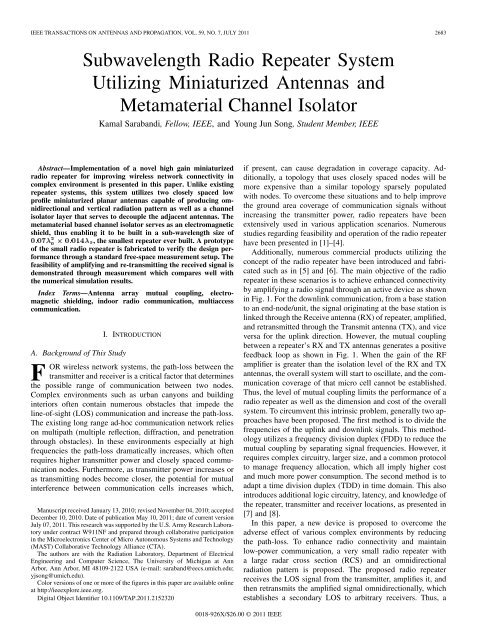
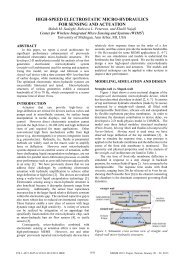
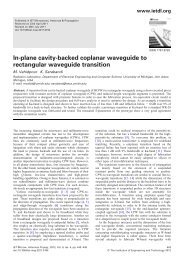
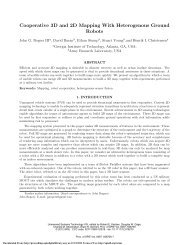
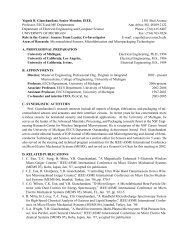
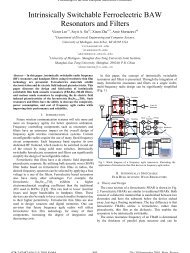
![[Sample B: Approval/Signature Sheet]](https://img.yumpu.com/34084789/1/190x245/sample-b-approval-signature-sheet.jpg?quality=85)
